List of South American dinosaurs facts for kids
This is a list of amazing dinosaurs whose bones have been found in South America. Get ready to explore some of the most incredible creatures that once roamed this continent!
Contents
Meet the Dinosaurs of South America
| Name | Year Found | Where They Lived (Formation) | Location | Cool Facts | Images |
|---|---|---|---|---|---|
| Abelisaurus | 1985 | Allen Formation?/Anacleto Formation? (Late Cretaceous, Campanian) | We only know this dinosaur from a part of its skull. | 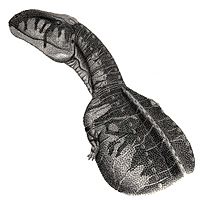 |
|
| Achillesaurus | 2007 | Bajo de la Carpa Formation (Late Cretaceous, Santonian) | It might be the same as Alvarezsaurus. |  |
|
| Adamantisaurus | 2006 | Adamantina Formation (Late Cretaceous, Turonian to Maastrichtian) | This titanosaur had special ball-and-socket joints in its tail bones. | 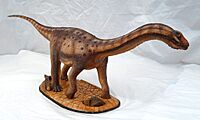 |
|
| Adeopapposaurus | 2009 | Cañón del Colorado Formation (Early Jurassic, Hettangian to Pliensbachian) | Its jaw bones suggest it might have had a beak like a bird. | 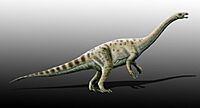 |
|
| Aeolosaurus | 1987 | Various formations (Late Cretaceous, Campanian to Maastrichtian) | We know this dinosaur from the remains of several different individuals. |  |
|
| Aerosteon | 2009 | Anacleto Formation?/Plottier Formation? (Late Cretaceous, Coniacian to Campanian) | Its bones had many air pockets, like the air sacs in modern birds. | 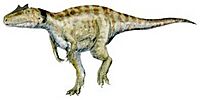 |
|
| Agustinia | 1999 | Lohan Cura Formation (Early Cretaceous, Aptian to Albian) | Scientists first thought it had spikes, but they were actually broken ribs. | ||
| Alnashetri | 2012 | Candeleros Formation (Late Cretaceous, Cenomanian) | This is the oldest alvarezsauroid found in South America. |  |
|
| Alvarezsaurus | 1991 | Bajo de la Carpa Formation (Late Cretaceous, Santonian) | It was one of the largest alvarezsaurids known. |  |
|
| Amargasaurus | 1991 | La Amarga Formation (Early Cretaceous, Barremian to Aptian) | It had two rows of spines on its neck, possibly covered in skin or keratin. |  |
|
| Amargatitanis | 2007 | La Amarga Formation (Early Cretaceous, Barremian to Aptian) | First thought to be a titanosaur, it's now seen as a different type of sauropod. |  |
|
| Amazonsaurus | 2003 | Itapecuru Formation (Early Cretaceous, Aptian to Albian) | This dinosaur had tall spines on its tail bones. |  |
|
| Amygdalodon | 1947 | Cerro Carnerero Formation (Early Jurassic, Toarcian) | Its teeth were shaped like almonds. | 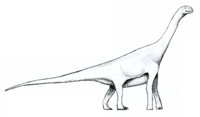 |
|
| Anabisetia | 2002 | Lisandro Formation (Late Cretaceous, Cenomanian to Turonian) | We have four specimens, but its skull is still mostly a mystery. |  |
|
| Andesaurus | 1991 | Candeleros Formation (Late Cretaceous, Cenomanian) | Its bone features show it was an early member of the Titanosauria group. |  |
|
| Aniksosaurus | 2006 | Bajo Barreal Formation (Late Cretaceous, Cenomanian to Turonian) | Many bones found together suggest it lived in groups. |  |
|
| Antarctosaurus | 1929 | Various formations (Late Cretaceous, Coniacian to Campanian) | Many bones were thought to be from this dinosaur, but some might be from others. | 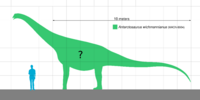 |
|
| Aoniraptor | 2016 | Huincul Formation (Late Cretaceous, Cenomanian to Turonian) | It might be a valid megaraptoran or the same as Gualicho. | ||
| Arackar | 2021 | Hornitos Formation (Late Cretaceous, Campanian to Maastrichtian) | This is the most complete sauropod dinosaur found in Chile. | 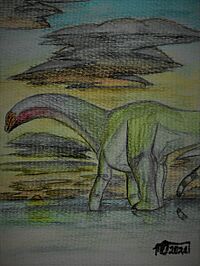 |
|
| Aratasaurus | 2020 | Romualdo Formation (Early Cretaceous, Albian) | All three of its toes were perfectly symmetrical. |  |
|
| Argentinosaurus | 1993 | Huincul Formation (Late Cretaceous, Cenomanian to Turonian) | This might be the largest dinosaur ever discovered! |  |
|
| Argyrosaurus | 1893 | Lago Colhué Huapí Formation (Late Cretaceous, Campanian to Maastrichtian) | Only the first discovered bones can be surely linked to this dinosaur. | 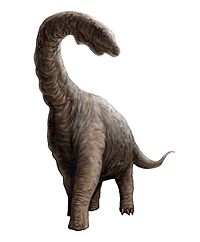 |
|
| Arrudatitan | 2021 | Adamantina Formation (Late Cretaceous, Campanian to Maastrichtian) | Its tail likely curved strongly downwards, almost touching the ground. |  |
|
| Asfaltovenator | 2019 | Cañadón Asfalto Formation (Early Jurassic, Toarcian) | It has features of two different dinosaur groups, making it unique. |  |
|
| Atacamatitan | 2011 | Tolar Formation (Late Cretaceous) | We only know this dinosaur from one incomplete skeleton. | 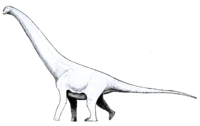 |
|
| Aucasaurus | 2002 | Anacleto Formation (Late Cretaceous, Santonian to Campanian) | We have almost a full skeleton, including most of its skull. |  |
|
| Austrocheirus | 2010 | Cerro Fortaleza Formation (Late Cretaceous, Campanian to Maastrichtian) | This abelisauroid had unusually long arms. |  |
|
| Austroposeidon | 2016 | Presidente Prudente Formation (Late Cretaceous, Campanian to Maastrichtian) | This is the largest dinosaur found in Brazil! |  |
|
| Austroraptor | 2008 | Allen Formation (Late Cretaceous, Campanian to Maastrichtian) | It had a long snout, similar to spinosaurids. |  |
|
| Baalsaurus | 2018 | Portezuelo Formation (Late Cretaceous, Turonian to Coniacian) | Its lower jaw was squared off, with teeth packed at the front. | ||
| Bagualia | 2020 | Cañadón Asfalto Formation (Early Jurassic, Toarcian) | This dinosaur appeared after a global warming event. | 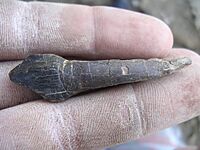 |
|
| Bagualosaurus | 2018 | Santa Maria Formation (Late Triassic, Carnian) | Its back legs were very strong and thick. |  |
|
| Bajadasaurus | 2019 | Bajada Colorada Formation (Early Cretaceous, Berriasian to Valanginian) | It had long, forward-pointing spines on its neck, in pairs. |  |
|
| Barrosasaurus | 2009 | Anacleto Formation (Late Cretaceous, Campanian) | We only have three well-preserved tail bones from this dinosaur. | 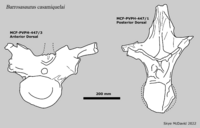 |
|
| Baurutitan | 2005 | Serra da Galga Formation (Late Cretaceous, Campanian to Maastrichtian) | It was first described from a series of nineteen backbones. |  |
|
| Berthasaura | 2021 | Goio-Erê Formation (Early Cretaceous, Aptian to Albian) | It had a short, toothless beak, meaning it ate plants or both plants and meat. | 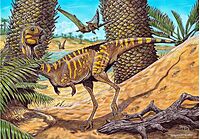 |
|
| Bicentenaria | 2012 | Candeleros Formation (Late Cretaceous, Cenomanian) | Several individuals were found together, suggesting they lived in groups. | 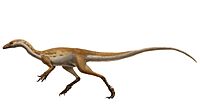 |
|
| Bonapartenykus | 2012 | Allen Formation (Late Cretaceous, Campanian to Maastrichtian) | Its fossil was found with two eggs, possibly still inside its body. | 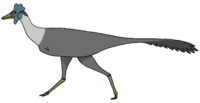 |
|
| Bonapartesaurus | 2017 | Allen Formation (Late Cretaceous, Campanian to Maastrichtian) | It belongs to a group of hadrosaurs unique to South America. |  |
|
| Bonatitan | 2004 | Allen Formation (Late Cretaceous, Campanian to Maastrichtian) | Its inner ear suggests it couldn't move its head as much as other sauropods. | ||
| Bonitasaura | 2004 | Bajo de la Carpa Formation (Late Cretaceous, Santonian) | Its body shape was similar to another dinosaur group, but they evolved this separately. | 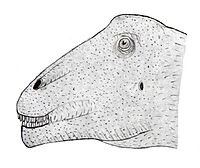 |
|
| Brachytrachelopan | 2005 | Cañadón Calcáreo Formation (Late Jurassic, Oxfordian to Tithonian) | This sauropod had the shortest neck of any known sauropod! | 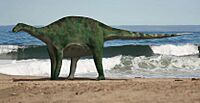 |
|
| Brasilotitan | 2013 | Adamantina Formation (Late Cretaceous, Maastrichtian) | Its lower jaw was L-shaped, similar to Antarctosaurus. | ||
| Bravasaurus | 2020 | Ciénaga del Río Huaco Formation (Late Cretaceous, Campanian to Maastrichtian) | It was found near a large group of titanosaur eggs. | ||
| Buitreraptor | 2005 | Candeleros Formation (Late Cretaceous, Cenomanian to Turonian) | Its long legs suggest it was a fast hunter. | 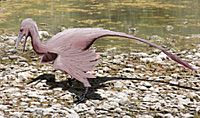 |
|
| Buriolestes | 2016 | Santa Maria Formation (Late Triassic, Carnian) | Unlike other sauropod relatives, this one was a meat-eater with sharp teeth. |  |
|
| Bustingorrytitan | 2023 | Huincul Formation (Late Cretaceous, Cenomanian to Turonian | It was a large dinosaur but not closely related to other giant titanosaurs. | 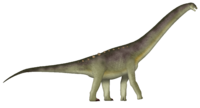 |
|
| Caieiria | 2022 | Serra da Galga Formation (Late Cretaceous, Maastrichtian) | Its tail bones had a very unusual shape. |  |
|
| Campylodoniscus | 1961 | Bajo Barreal Formation? (Late Cretaceous, Cenomanian) | We only know this dinosaur from a single upper jaw bone with seven teeth. | 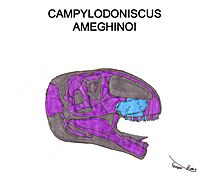 |
|
| Carnotaurus | 1985 | La Colonia Formation (Late Cretaceous, Maastrichtian) | This dinosaur had two short horns on top of its skull. | 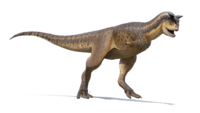 |
|
| Cathartesaura | 2005 | Huincul Formation (Late Cretaceous, Cenomanian) | It had a strong neck, but it couldn't move it much up or down. | 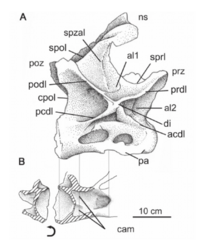 |
|
| Chilesaurus | 2015 | Toqui Formation (Late Jurassic, Tithonian) | This dinosaur has a mix of features from different dinosaur groups, which is very rare! | 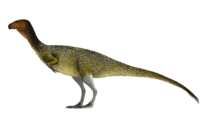 |
|
| Choconsaurus | 2017 | Huincul Formation (Late Cretaceous, Cenomanian) | It's one of the more complete early titanosaurs we know. |  |
|
| Chromogisaurus | 2010 | Ischigualasto Formation (Late Triassic, Carnian) | Its discovery showed that early dinosaurs were more varied than we thought. |  |
|
| Chubutisaurus | 1975 | Cerro Barcino Formation (Early Cretaceous, Albian) | Unusually, its front limbs were shorter than its back limbs. |  |
|
| Chucarosaurus | 2023 | Huincul Formation (Late Cretaceous, Cenomanian to Turonian) | It was smaller and thinner than the giant Argentinosaurus that lived at the same time. |  |
|
| Clasmodosaurus | 1898 | Bajo Barreal Formation (Late Cretaceous, Cenomanian to Turonian) | Like Bonitasaura, its teeth had a polygon shape when cut across. | ||
| Coloradisaurus | 1990 | Los Colorados Formation (Late Triassic, Norian) | It was first called Coloradia, but that name was already taken by a moth. | 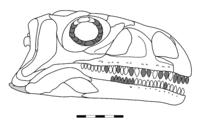 |
|
| Comahuesaurus | 2012 | Lohan Cura Formation (Early Cretaceous, Aptian to Albian) | Its bones were first thought to be from Limaysaurus, but it's a separate genus. |  |
|
| Condorraptor | 2005 | Cañadón Asfalto Formation (Early Jurassic, Toarcian) | It's closely related to Piatnitzkysaurus but has some key differences in its bones. | 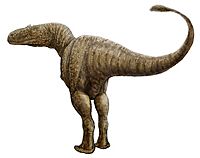 |
|
| Dreadnoughtus | 2014 | Cerro Fortaleza Formation (Late Cretaceous, Campanian to Maastrichtian) | This is the heaviest land animal whose weight can be estimated quite accurately. | 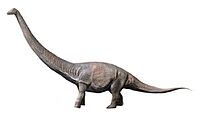 |
|
| Drusilasaura | 2011 | Bajo Barreal Formation (Late Cretaceous, Cenomanian to Turonian) | It might be the oldest known member of a group called lognkosaurians. | 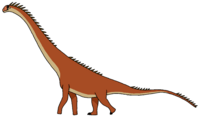 |
|
| Ekrixinatosaurus | 2004 | Candeleros Formation (Late Cretaceous, Cenomanian) | It had strong bones, meaning it was very tough and could resist injuries. |  |
|
| Elaltitan | 2012 | Bajo Barreal Formation (Late Cretaceous, Cenomanian to Turonian) | Its long thigh bone shows it was an extremely large dinosaur. | 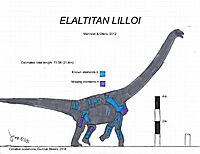 |
|
| Elemgasem | 2022 | Portezuelo Formation (Late Cretaceous, Turonian to Coniacian) | This was the first abelisaurid found from this specific time period. | ||
| Eoabelisaurus | 2012 | Cañadón Asfalto Formation (Early Jurassic, Toarcian) | Its arms show a mix of old and new features for an abelisauroid. |  |
|
| Eodromaeus | 2011 | Ischigualasto Formation (Late Triassic, Carnian | Even though it was an early dinosaur, it was well-suited for running fast. | 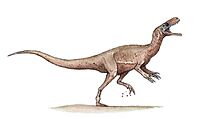 |
|
| Eoraptor | 1993 | Ischigualasto Formation (Late Triassic, Carnian) | It had different kinds of teeth, suggesting it ate both plants and meat. |  |
|
| Epachthosaurus | 1990 | Bajo Barreal Formation (Late Cretaceous, Cenomanian to Turonian) | Its tail bones were concave at the front and convex at the back. | 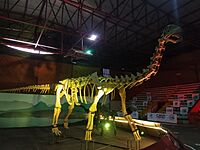 |
|
| Erythrovenator | 2021 | Candelária Formation (Late Triassic, Carnian to Norian) | It was found in an area where mammal-like reptiles were very common. |  |
|
| Futalognkosaurus | 2007 | Portezuelo Formation (Late Cretaceous, Coniacian) | It had very deep neck bones with unique shark fin-shaped spines. | 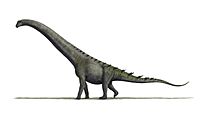 |
|
| Gasparinisaura | 1996 | Anacleto Formation (Late Cretaceous, Campanian) | We have found both adult and young specimens of this dinosaur. |  |
|
| Genyodectes | 1901 | Cerro Barcino Formation (Early Cretaceous, Aptian to Albian) | This dinosaur had very large, sticking-out teeth. |  |
|
| Giganotosaurus | 1995 | Candeleros Formation (Late Cretaceous, Cenomanian) | It was one of the largest meat-eating dinosaurs to ever walk the Earth! | 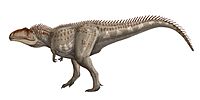 |
|
| Gnathovorax | 2019 | Santa Maria Formation (Late Triassic, Carnian) | We have a very well-preserved, almost complete skeleton of this dinosaur. | 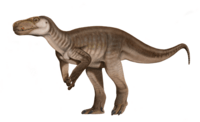 |
|
| Gondwanatitan | 1999 | Adamantina Formation, Cambabe Formation? (Late Cretaceous, Maastrichtian) | For a titanosaur, its limb bones were quite slender. | 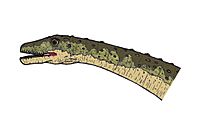 |
|
| Gonkoken | 2023 | Dorotea Formation (Late Cretaceous, Campanian to Maastrichtian) | This is the southernmost hadrosaur relative found so far. |  |
|
| Guaibasaurus | 1999 | Caturrita Formation (Late Triassic, Norian) | It has features of both early meat-eating dinosaurs and long-necked sauropod relatives. | 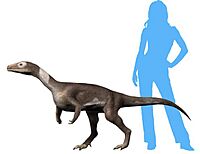 |
|
| Gualicho | 2016 | Huincul Formation (Late Cretaceous, Cenomanian to Turonian) | It was first thought to have tiny arms with only two fingers, like T. rex. |  |
|
| Guemesia | 2022 | Los Blanquitos Formation (Late Cretaceous, Campanian) | Unlike other abelisaurids, its skull had no fancy bumps or ridges. | 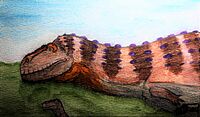 |
|
| Herrerasaurus | 1963 | Ischigualasto Formation (Late Triassic, Carnian) | This was one of the largest early meat-eating dinosaurs. | 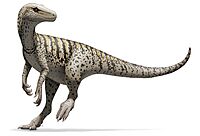 |
|
| Huallasaurus | 2022 | Los Alamitos Formation (Late Cretaceous, Santonian to Maastrichtian) | Its bones were first wrongly identified as belonging to a different dinosaur. |  |
|
| Huinculsaurus | 2020 | Huincul Formation (Late Cretaceous, Cenomanian to Turonian) | This is the youngest known elaphrosaurine dinosaur. |  |
|
| Ibirania | 2022 | São José do Rio Preto Formation (Late Cretaceous, Santonian to Campanian) | It might have been small because of its dry inland home, not island dwarfism. | 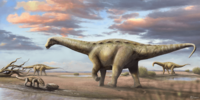 |
|
| Ilokelesia | 1998 | Huincul Formation (Late Cretaceous, Cenomanian) | Its skull still has some older features of abelisauroids. |  |
|
| Inawentu | 2023 | Bajo de la Carpa Formation (Late Cretaceous, Santonian) | It had a short neck and a squared snout, similar to dinosaurs that lived earlier. |  |
|
| Ingentia | 2018 | Quebrada del Barro Formation (Late Triassic, Norian to Rhaetian) | This is the earliest known very large sauropod relative. |  |
|
| Irritator | 1996 | Romualdo Formation (Early Cretaceous, Albian) | It might have been the top predator in its area, hunting both in water and on land. |  |
|
| Isaberrysaura | 2017 | Los Molles Formation (Middle Jurassic, Bajocian) | Its fossil preserves what it ate, including whole seeds! |  |
|
| Isasicursor | 2019 | Chorrillo Formation (Late Cretaceous, Campanian to Maastrichtian) | Four individuals of different ages were found together, suggesting they lived in herds. |  |
|
| Itapeuasaurus | 2019 | Alcântara Formation (Late Cretaceous, Cenomanian) | We only know this dinosaur from six backbones. |  |
|
| Jakapil | 2022 | Candeleros Formation (Late Cretaceous, Cenomanian) | This small, bipedal dinosaur with deep jaws is a new type of ornithischian. |  |
|
| Kaijutitan | 2019 | Sierra Barrosa Formation (Late Cretaceous, Coniacian) | It's one of the last surviving early titanosaurs. | ||
| Katepensaurus | 2013 | Bajo Barreal Formation (Late Cretaceous, Cenomanian to Turonian) | It's special because of a certain opening in its backbones. |  |
|
| Kelumapusaura | 2022 | Allen Formation (Late Cretaceous, Campanian to Maastrichtian) | We know this dinosaur from the bones of many different individuals. | 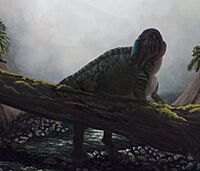 |
|
| Kurupi | 2021 | Marília Formation (Late Cretaceous, Maastrichtian) | Its tail would have been stiff due to the shape of its tail bones. | 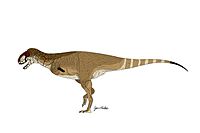 |
|
| Lajasvenator | 2020 | Mulichinco Formation (Early Cretaceous, Valanginian) | This is one of the smallest allosauroids known. | 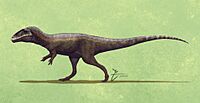 |
|
| Lapampasaurus | 2012 | Allen Formation (Late Cretaceous, Campanian to Maastrichtian) | We have a partial skeleton, but the skull is missing. | ||
| Laplatasaurus | 1929 | Anacleto Formation (Late Cretaceous, Campanian) | Some bony plates were thought to be from this dinosaur, but it's not certain. |  |
|
| Laquintasaura | 2014 | La Quinta Formation (Early Jurassic, Hettangian) | One study suggested it was an early armored dinosaur, even without armor found. |  |
|
| Lavocatisaurus | 2018 | Rayoso Formation (Early Cretaceous, Aptian to Albian) | It might have had a beak made of keratin, like a bird's beak. | 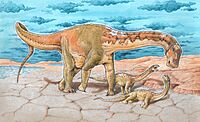 |
|
| Leinkupal | 2014 | Bajada Colorada Formation (Early Cretaceous, Berriasian to Valanginian) | This is the youngest known diplodocid dinosaur. | 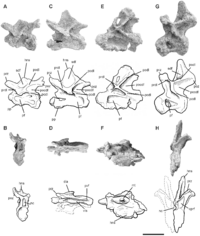 |
|
| Leonerasaurus | 2011 | Las Leoneras Formation (Early Jurassic, Sinemurian to Toarcian) | It has a strange mix of old and new features in its bones. | 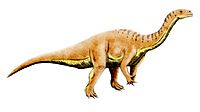 |
|
| Lessemsaurus | 1999 | Los Colorados Formation (Late Triassic, Norian) | It grew very large, even without the usual features for giant size. | 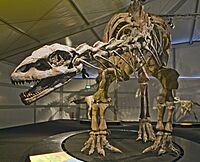 |
|
| Leyesaurus | 2011 | Quebrada del Barro Formation (Early Jurassic, Hettangian to Toarcian) | This dinosaur had an unusually small skull. | 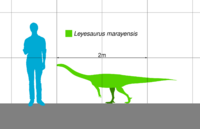 |
|
| Ligabueino | 1996 | La Amarga Formation (Early Cretaceous, Barremian to Aptian) | We only know this dinosaur from one very small, young skeleton. | ||
| Ligabuesaurus | 2006 | Lohan Cura Formation (Early Cretaceous, Aptian to Albian) | Its front limbs were extremely long, like those of brachiosaurids. |  |
|
| Limaysaurus | 2004 | Candeleros Formation, Huincul Formation (Late Cretaceous, Cenomanian) | It had long spines on its backbones. |  |
|
| Llukalkan | 2021 | Bajo de la Carpa Formation (Late Cretaceous, Santonian) | It might have had excellent hearing due to the shape of its ear. | ||
| Loncosaurus | 1899 | Cardiel Formation?/Metasiete Formation? (Late Cretaceous, Campanian to Maastrichtian) | We don't know much about this dinosaur. | ||
| Loricosaurus | 1929 | Allen Formation (Late Cretaceous, Maastrichtian) | It might be the same as Neuquensaurus or Saltasaurus. | ||
| Lucianovenator | 2017 | Quebrada del Barro Formation (Late Triassic, Norian to Rhaetian) | It's one of the few meat-eating dinosaurs known from this time. |  |
|
| Macrocollum | 2018 | Candelária Formation (Late Triassic, Norian) | This is one of the oldest sauropod relatives with a very long neck. |  |
|
| Macrogryphosaurus | 2007 | Sierra Barrosa Formation (Late Cretaceous, Coniacian) | It has a series of bony plates preserved along its body. |  |
|
| Mahuidacursor | 2019 | Bajo de la Carpa Formation (Late Cretaceous, Santonian) | The main specimen was sexually mature but not fully grown. | ||
| Maip | 2022 | Chorrillo Formation (Late Cretaceous, Maastrichtian) | This is the largest, youngest, and most complete megaraptoran known. | 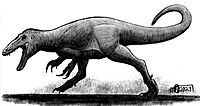 |
|
| Malarguesaurus | 2008 | Portezuelo Formation (Late Cretaceous, Turonian to Coniacian) | It was a large and strongly built dinosaur. | ||
| Manidens | 2011 | Cañadón Asfalto Formation (Early Jurassic, Toarcian) | Its foot structure suggests it might have lived in trees, with toes for grasping. |  |
|
| Mapusaurus | 2006 | Huincul Formation (Late Cretaceous, Cenomanian to Turonian) | At least seven specimens were found, possibly showing they lived or hunted in packs. |  |
|
| Maxakalisaurus | 2006 | Adamantina Formation (Late Cretaceous, Maastrichtian) | Unusually for a sauropod, it had ridged teeth. |  |
|
| Megaraptor | 1998 | Portezuelo Formation (Late Cretaceous, Turonian to Coniacian) | It had a large, very curved claw on its first finger. | 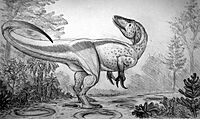 |
|
| Mendozasaurus | 2003 | Sierra Barrosa Formation (Late Cretaceous, Coniacian) | It had round bony plates, probably in rows along its sides. |  |
|
| Menucocelsior | 2022 | Allen Formation (Late Cretaceous, Maastrichtian) | It lived with other titanosaurs, likely sharing resources in different ways. | ||
| Meraxes | 2022 | Huincul Formation (Late Cretaceous, Cenomanian) | It had small front limbs, similar to other groups of meat-eating dinosaurs. | 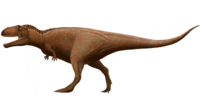 |
|
| Microcoelus | 1893 | Bajo de la Carpa Formation (Late Cretaceous, Santonian to Campanian) | It might be the same as Neuquensaurus. | 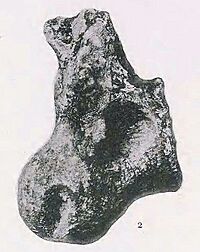 |
|
| Mirischia | 2004 | Romualdo Formation (Early Cretaceous, Albian) | Its fossil preserves parts of its intestines! |  |
|
| Murusraptor | 2016 | Sierra Barrosa Formation (Late Cretaceous, Coniacian) | Its brain was like a T. rex's, but its senses were more like other large meat-eaters. | 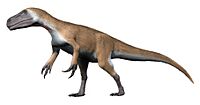 |
|
| Mussaurus | 1979 | Laguna Colorada Formation (Early Jurassic, Sinemurian) | We have many specimens from different ages. Young ones might have walked on four legs. |  |
|
| Muyelensaurus | 2007 | Plottier Formation (Late Cretaceous, Coniacian to Santonian) | It was quite slender for a titanosaur. | ||
| Narambuenatitan | 2011 | Anacleto Formation (Late Cretaceous, Campanian) | Its backbones are very similar to those of Epachthosaurus. | 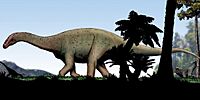 |
|
| Neuquenraptor | 2005 | Portezuelo Formation (Late Cretaceous, Coniacian) | It might be the same as Unenlagia. |  |
|
| Neuquensaurus | 1992 | Anacleto Formation (Late Cretaceous, Campanian) | This is one of the smallest titanosaurs known. | 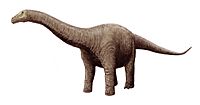 |
|
| Nhandumirim | 2019 | Santa Maria Formation (Late Triassic, Carnian) | It was first thought to be a meat-eater, but now it's seen as a sauropod relative. |  |
|
| Niebla | 2020 | Allen Formation (Late Cretaceous, Campanian to Maastrichtian) | It had a uniquely shaped shoulder bone, very similar to Carnotaurus. | 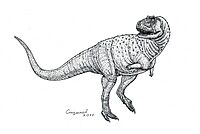 |
|
| Ninjatitan | 2021 | Bajada Colorada Formation (Early Cretaceous, Berriasian to Valanginian) | This is the oldest known titanosaur dinosaur. | ||
| Noasaurus | 1980 | Lecho Formation (Late Cretaceous, Campanian to Maastrichtian) | It was mistakenly thought to have a sickle-shaped claw, like a raptor. |  |
|
| Nopcsaspondylus | 2007 | Candeleros Formation (Late Cretaceous, Cenomanian) | It's named from a single backbone that is now lost. |  |
|
| Notoceratops | 1918 | Lago Colhué Huapí Formation (Late Cretaceous, Campanian to Maastrichtian) | It was first thought to be a ceratopsian, but this is now doubted. | 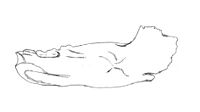 |
|
| Notocolossus | 2016 | Plottier Formation (Late Cretaceous, Coniacian to Santonian) | Unusually for a sauropod, its toe claws were flattened. | 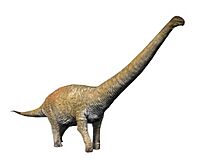 |
|
| Notohypsilophodon | 1998 | Bajo Barreal Formation (Late Cretaceous, Cenomanian to Turonian) | We only know this dinosaur from a young skeleton without a skull. |  |
|
| Nullotitan | 2019 | Chorrillo Formation (Late Cretaceous, Campanian to Maastrichtian) | It would have shared its habitat with smaller plant-eating dinosaurs. |  |
|
| Orkoraptor | 2008 | Cerro Fortaleza Formation (Late Cretaceous, Campanian) | It had very special teeth, similar to bird-like dinosaurs. |  |
|
| Overoraptor | 2020 | Huincul Formation (Late Cretaceous, Cenomanian to Turonian) | It shows features for both flying and running. | 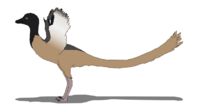 |
|
| Overosaurus | 2013 | Bajo de la Carpa Formation (Late Cretaceous, Santonian) | This is one of the smallest aeolosaurin dinosaurs known. | 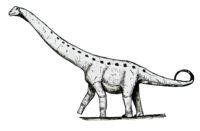 |
|
| Padillasaurus | 2015 | Paja Formation (Early Cretaceous, Barremian) | It was first thought to be a brachiosaurid, but it could also be a somphospondylian. |  |
|
| Pampadromaeus | 2011 | Santa Maria Formation (Late Triassic, Carnian) | Some features of its jaws are similar to meat-eating dinosaurs. | 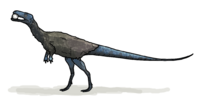 |
|
| Pamparaptor | 2011 | Portezuelo Formation (Late Cretaceous, Turonian to Coniacian) | It had a foot bone similar to troodontids. | 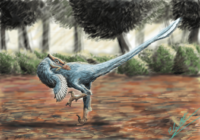 |
|
| Panamericansaurus | 2010 | Allen Formation (Late Cretaceous, Campanian to Maastrichtian) | We only know this dinosaur from one partial skeleton. | ||
| Pandoravenator | 2017 | Cañadón Calcáreo Formation (Late Jurassic, Oxfordian to Tithonian) | Its place in the dinosaur family tree is not clear. | ||
| Panphagia | 2009 | Ischigualasto Formation (Late Triassic, Carnian) | It ate both plants and meat, as shown by its different types of teeth. |  |
|
| Patagonykus | 1996 | Portezuelo Formation (Late Cretaceous, Turonian to Coniacian) | Its discovery helped scientists link different groups of dinosaurs. |  |
|
| Patagopelta | 2022 | Allen Formation (Late Cretaceous, Campanian to Maastrichtian) | This is the first nodosaurid armored dinosaur found in South America. | 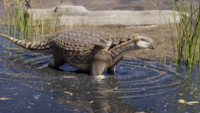 |
|
| Patagosaurus | 1979 | Cañadón Asfalto Formation (Early Jurassic, Toarcian) | We have bones from both adults and young ones, showing how they grew. |  |
|
| Patagotitan | 2017 | Cerro Barcino Formation (Early Cretaceous, Albian) | This is one of the largest dinosaurs known from fairly complete remains. | 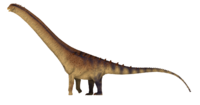 |
|
| Pellegrinisaurus | 1996 | Allen Formation (Late Cretaceous, Campanian to Maastrichtian) | It might have lived inland, unlike other titanosaurs of its time. | 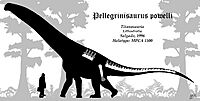 |
|
| Perijasaurus | 2022 | La Quinta Formation (Early Jurassic to Middle Jurassic, Toarcian to Aalenian) | We only know this dinosaur from a single backbone. | ||
| Petrobrasaurus | 2011 | Plottier Formation (Late Cretaceous, Coniacian to Santonian) | It shares some features with lognkosaurs, but its exact group is not confirmed. |  |
|
| Piatnitzkysaurus | 1979 | Cañadón Asfalto Formation (Early Jurassic, Toarcian) | It's one of the few early meat-eating dinosaurs with a well-preserved braincase. |  |
|
| Pilmatueia | 2019 | Mulichinco Formation (Early Cretaceous, Valanginian) | It had long spines on its neck bones, but not as tall as Amargasaurus. | ||
| Pitekunsaurus | 2008 | Anacleto Formation (Late Cretaceous, Campanian) | We have several bones from different parts of its body, including its braincase. | 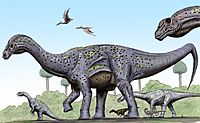 |
|
| Powellvenator | 2017 | Los Colorados Formation (Late Triassic, Norian) | Some of its bones were first thought to belong to a different type of reptile. | ||
| Puertasaurus | 2005 | Cerro Fortaleza Formation (Late Cretaceous, Campanian to Maastrichtian) | It was huge, but we only have a few bones from it. | 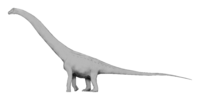 |
|
| Punatitan | 2020 | Ciénaga del Río Huaco Formation (Late Cretaceous, Campanian to Maastrichtian) | It lived at the same time as Bravasaurus but was likely not closely related. | ||
| Pycnonemosaurus | 2002 | Cachoeira do Bom Jardim Formation (Late Cretaceous, Campanian) | This might be the largest abelisaurid dinosaur known. | 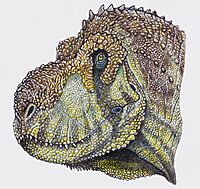 |
|
| Quetecsaurus | 2014 | Lisandro Formation (Late Cretaceous, Turonian) | Its upper arm bone had a unique shape. |  |
|
| Quilmesaurus | 2001 | Allen Formation (Late Cretaceous, Campanian to Maastrichtian) | It had strong, thick legs despite its small size. |  |
|
| Rayososaurus | 1996 | Candeleros Formation (Late Cretaceous, Cenomanian) | It's very similar to Rebbachisaurus, even though we only have a few bones. |  |
|
| Rinconsaurus | 2003 | Bajo de la Carpa Formation (Late Cretaceous, Santonian) | Its tail bones had a strange repeating pattern of shapes. | 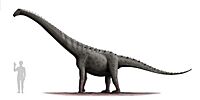 |
|
| Riojasaurus | 1969 | Los Colorados Formation (Late Triassic, Norian) | Although often shown on four legs, its shoulder bones suggest it might have walked on two. | 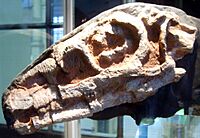 |
|
| Rocasaurus | 2000 | Allen Formation (Late Cretaceous, Campanian to Maastrichtian) | It was small for a sauropod but very strongly built. |  |
|
| Saltasaurus | 1980 | Lecho Formation (Late Cretaceous, Maastrichtian) | It had bony armor plates on its skin, like large round bumps connected by smaller plates. | 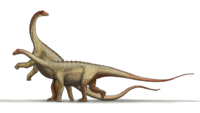 |
|
| Sanjuansaurus | 2010 | Ischigualasto Formation (Late Triassic, Carnian) | It lived at the same time as Herrerasaurus but was likely a different species. | 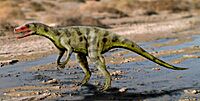 |
|
| Santanaraptor | 1999 | Romualdo Formation (Early Cretaceous, Aptian to Albian) | Its fossil preserves soft tissues, like skin, muscle, and possibly blood vessels! |  |
|
| Sarmientosaurus | 2016 | Bajo Barreal Formation (Late Cretaceous, Cenomanian to Turonian) | Its inner ear suggests it held its head downwards, possibly eating low-growing plants. | 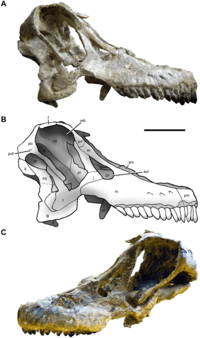 |
|
| Saturnalia | 1999 | Santa Maria Formation (Late Triassic, Carnian) | We know this dinosaur from at least three partial skeletons. | 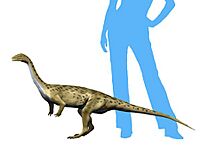 |
|
| Secernosaurus | 1979 | Lago Colhué Huapí Formation (Late Cretaceous, Campanian to Maastrichtian) | It would have lived in a dry, gypsum desert. |  |
|
| Sektensaurus | 2019 | Lago Colhué Huapí Formation (Late Cretaceous, Campanian) | This is the first non-hadrosaurid ornithopod found in central Patagonia. | ||
| Skorpiovenator | 2009 | Huincul Formation (Late Cretaceous, Cenomanian to Turonian) | It had an unusually short and deep skull. |  |
|
| Spectrovenator | 2020 | Quiricó Formation (Early Cretaceous, Barremian to Aptian) | Its main fossil was found underneath a sauropod skeleton. |  |
|
| Staurikosaurus | 1970 | Santa Maria Formation (Late Triassic, Carnian to Norian) | Only two specimens are known, suggesting it was rare in its environment. | 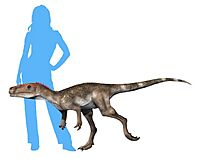 |
|
| Stegouros | 2021 | Dorotea Formation (Late Cretaceous, Campanian to Maastrichtian) | It had a unique "macuahuitl" tail weapon, made of connected bony plates. |  |
|
| Tachiraptor | 2014 | La Quinta Formation (Early Jurassic, Hettangian) | It's closely related to ceratosaurs and tetanurans. | 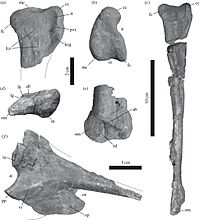 |
|
| Talenkauen | 2004 | Cerro Fortaleza Formation (Late Cretaceous, Campanian to Maastrichtian) | An adult and a baby were found together, suggesting they cared for their young. |  |
|
| Tapuiasaurus | 2011 | Quiricó Formation (Early Cretaceous, Aptian) | It's one of the few titanosaurs for which we have a complete skull. |  |
|
| Taurovenator | 2016 | Huincul Formation (Late Cretaceous, Cenomanian to Turonian) | We only know this dinosaur from one bone behind its eye. It might be the same as Mapusaurus. | 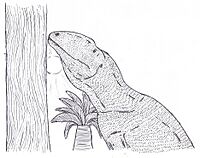 |
|
| Tehuelchesaurus | 1999 | Cañadón Calcáreo Formation (Late Jurassic, Oxfordian to Tithonian) | Its fossil preserves impressions of its scaly skin! |  |
|
| Thanos | 2020 | São José do Rio Preto Formation (Late Cretaceous, Santonian) | We only know this dinosaur from a single backbone. Its name honors the Marvel villain Thanos. |  |
|
| Tralkasaurus | 2020 | Huincul Formation (Late Cretaceous, Cenomanian to Turonian) | It has a mix of old and new features from different abelisauroid groups. | ||
| Tratayenia | 2018 | Bajo de la Carpa Formation (Late Cretaceous, Santonian) | This is one of the youngest megaraptorans known. | 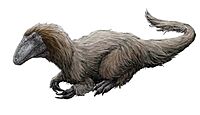 |
|
| Traukutitan | 2011 | Bajo de la Carpa Formation (Late Cretaceous, Santonian) | Its tail bones kept some older features despite living later in time. | ||
| Trigonosaurus | 2005 | Serra da Galga Formation (Late Cretaceous, Maastrichtian) | It might be the same as Baurutitan. |  |
|
| Triunfosaurus | 2017 | Rio Piranhas Formation (Early Cretaceous, Berriasian to Valanginian) | It was first called a titanosaur, but it also has similarities to other early sauropods. | ||
| Tyrannotitan | 2005 | Cerro Barcino Formation (Early Cretaceous, Aptian) | Unlike other carcharodontosaurids, its hip and tail bones were not filled with air. | 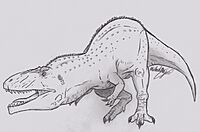 |
|
| Uberabatitan | 2008 | Serra da Galga Formation (Late Cretaceous, Maastrichtian) | Several large individuals of this dinosaur have been found. | 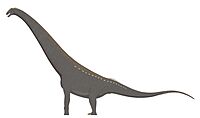 |
|
| Unaysaurus | 2004 | Caturrita Formation (Late Triassic, Carnian to Norian) | This was the first plateosaurid-like sauropod relative found in Brazil. | 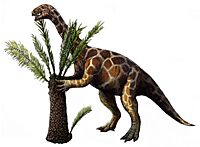 |
|
| Unenlagia | 1997 | Portezuelo Formation (Late Cretaceous, Coniacian) | Its shoulder structure suggests it might have been able to flap its arms. |  |
|
| Unquillosaurus | 1979 | Los Blanquitos Formation (Late Cretaceous, Campanian) | It has been suggested to be a dromaeosaurid or a carcharodontosaurid. | ||
| Velocisaurus | 1991 | Bajo de la Carpa Formation (Late Cretaceous, Santonian) | Its third foot bone was unusually thick, possibly helping it run fast. |  |
|
| Vespersaurus | 2019 | Rio Paraná Formation (Cretaceous) | It had raised claws on its second and fourth toes, making it walk on one toe, possibly for desert life. | 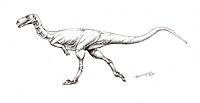 |
|
| Viavenator | 2016 | Bajo de la Carpa Formation (Late Cretaceous, Santonian) | It might have used quick head movements and steady gaze when hunting. |  |
|
| Volkheimeria | 1979 | Cañadón Asfalto Formation (Early Jurassic, Toarcian) | It lived alongside at least three other long-necked sauropods. | ||
| Willinakaqe | 2010 | Allen Formation (Late Cretaceous, Campanian to Maastrichtian) | The original description mixed bones from two different dinosaurs. |  |
|
| Xenotarsosaurus | 1986 | Bajo Barreal Formation (Late Cretaceous, Cenomanian to Turonian) | It had unusually shaped ankle bones. | 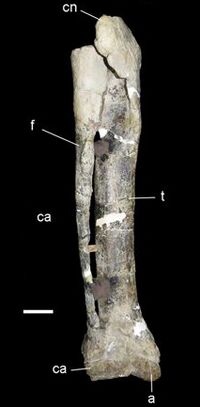 |
|
| Yamanasaurus | 2019 | Río Playas Formation (Late Cretaceous, Maastrichtian) | This is the northernmost saltasaurine found so far. |  |
|
| Ypupiara | 2021 | Serra da Galga Formation (Late Cretaceous, Maastrichtian) | Its teeth suggest it might have eaten fish. |  |
|
| Zapalasaurus | 2006 | La Amarga Formation (Early Cretaceous, Hauterivian to Aptian) | We have an incomplete skeleton, including some tail bones. |  |
|
| Zupaysaurus | 2003 | Los Colorados Formation (Late Triassic, Norian) | It's often shown with head crests, but these might actually be misplaced bones from its eye area. |  |
Other Interesting Dinosaurs
Some dinosaurs are known from very few bones, or their names are still being debated by scientists. Here are a few:
- Angaturama limai: We only have the tip of its snout. It might be the same as Irritator, or it could be a unique species.
- "Bayosaurus pubica": This abelisaurid is known from some body bones.
- Oxalaia quilombensis: This dinosaur might be the same as the famous Spinosaurus.
- "Ubirajara jubatus": This dinosaur fossil showed impressions of feathers, including special display feathers. However, its description was pulled back because the fossil might have been illegally taken from Brazil.
Timeline of South American Dinosaurs
This timeline shows when some of these dinosaurs lived. Time is measured in millions of years (Ma). Red means they were meat-eaters, green means they ate plants, and blue means they ate both.
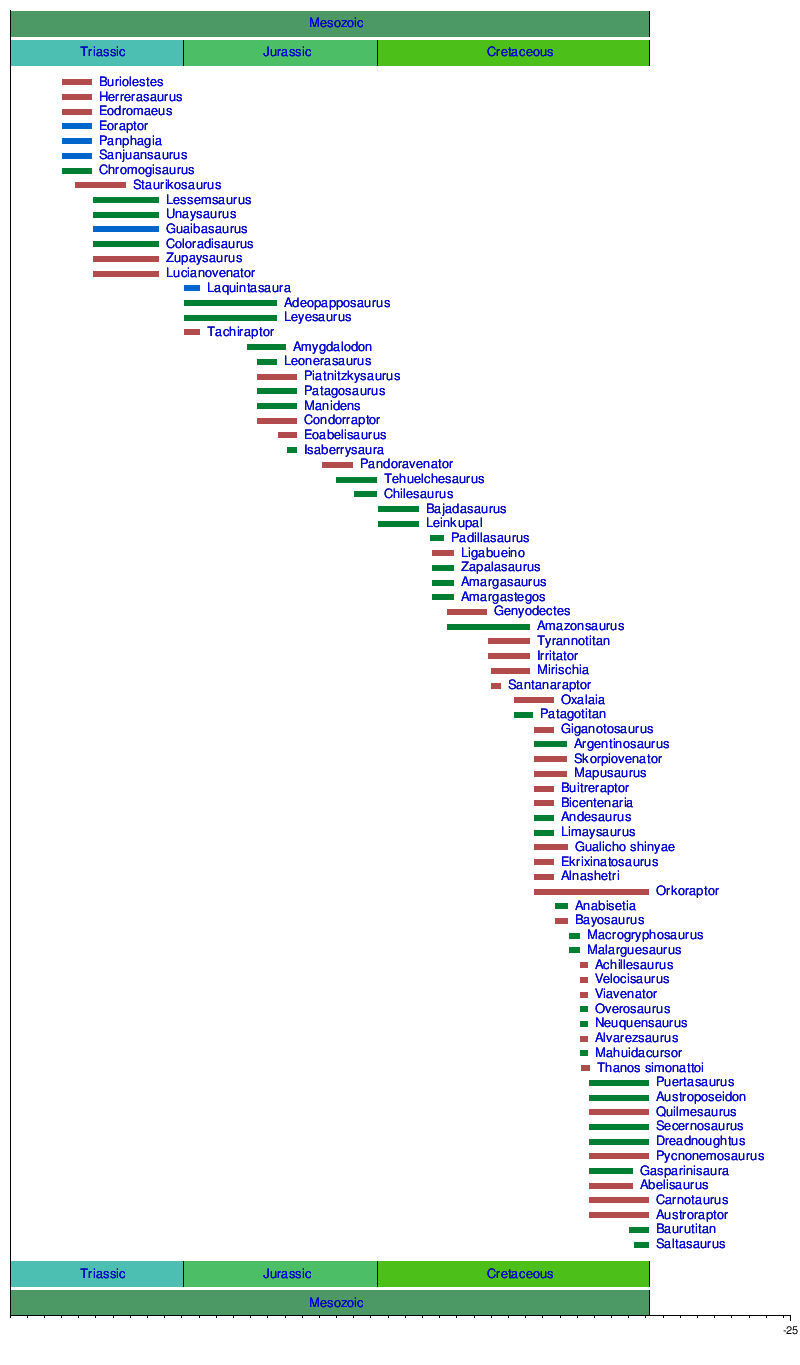
See also
- List of birds of South America

All content from Kiddle encyclopedia articles (including the article images and facts) can be freely used under Attribution-ShareAlike license, unless stated otherwise. Cite this article:
List of South American dinosaurs Facts for Kids. Kiddle Encyclopedia.
